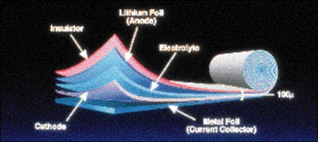Electric vehicles spur development
of lithium-polymer batteries
Designers of electric vehicles, backup power systems, and other battery-powered equipment requiring long life and high energy density will soon have a new battery option to consider: lithium-polymer. 3M (St. Paul, MN) and Hydro-Quebec, a Montreal, Canada-based utility, have teamed up with scientists at the U.S. Dept.of Energy's Argonne National Laboratory (Batavia, IL) to develop lithium-polymer batteries that can operate an electric vehicle for a range of 150 miles or more.

Lithium-polymer batteries use a solid-plastic electrolyte between
anode and cathode layers, along with a metal foil for the current
collector and an insulator.
Both companies hope to produce full-size prototypes of lithium-polymer battery packs for field testing in the near future–the culmination of a five-year research effort funded by the U.S. Advanced Battery Consortium (USABC), based in Dearborn, MI. The companies took a step toward that goal at the recent 14th International Electric Vehicle Symposium in Orlando, FL, when they demonstrated a lithium-polymer battery pack for an electric vehicle. Beyond that, the USABC is aiming further R&D efforts to increase lithium-polymer's performance and reduce its manufacturing cost for high-volume production requirements.
The lithium-polymer battery is a solid-state design that uses a solid-plastic electrolyte between anode and cathode layers, instead of a liquid. Completing the battery's five-layer structure is a metal foil for the current collector and an insulator (see figure ). The solid lithium-polymer electrolyte is not subject to leaking and will not react at most temperatures, unlike the liquid electrolytes used in other lithium-battery chemistries.
Moreover, the solid electrolyte material can be produced in continuous rolls or in stacks sufficient to form modules that can supply the amount of power needed. This construction allows the battery to be made lightweight and to be formed into various shapes, giving the product designer flexibility.
Under goals set by the USABC, the lithium-polymer battery is expected to have a specific energy of 200 Wh/kg. This is higher than the 35 Wh/kg characteristic of lead-acid, the most common chemistry currently used in electric vehicles. The lithium-polymer's cycle life will be comparable to lead-acid's 600 cycles. For more information from Hydro-Quebec, contact Jean Dionne at 514-289-2211, ext. 4053, e-mail , or circle 489. For more from 3M, contact Warren Vollmer of 3M at 612-733-0384, e-mail wevollmar@mmm.com .
–Spencer Chin
Advertisement





